Photo: istockphoto.com
Driving is a luxury that many people across the country enjoy, but if proper care isn’t taken to maintain a vehicle, it can result in rapid wear, part failure, and poor control. Tires are one of the features of a car that can sometimes be overlooked, but it’s important to ensure that you know how to use a gauge to check tire pressure. Underinflated tires increase braking distance, reduce steering control, and accelerate tire wear, which can result in complete tire failure. Overinflated tires are not as hazardous, but they can still increase tire wear, affect the wear pattern of the treads, and reduce control. To ensure that your tires are not under- or overinflated, it’s necessary to understand how to use a tire pressure gauge.
Tools & MaterialsIt’s best to check the tire pressure when the tires are cold, such as first thing in the morning or after the vehicle has been parked in the shade for several hours. This helps to increase the accuracy of the readings. In order to test tire pressure, you’ll need to purchase a viable tool such as this tire pressure gauge—a favorite in our researched guide to the best tire pressure gauges.
Advertisement
Learning how to use a low-pressure tire gauge is relatively simple, though you will need to find the manufacturer’s recommended PSI before you can begin. While it may seem like the first thing to do is take out the tire pressure gauge, that wouldn’t get you very far unless you already knew the manufacturer’s recommended PSI for the tires. Given that most people don’t typically memorize this information, it’s a good idea to check and verify before using the tire pressure gauge.
Tire and loading information is commonly included in the owner’s manual, though you may also be able to find it on a sticker on the driver’s side door, near the trunk lid, inside the fuel door, or even inside the console. Look for a two-digit number, like 35, followed by PSI, which means pounds per square inch.
Related: The Best Jump Starters With Air Compressors for Your Car
Photo: istockphoto.com
STEP 2: Locate the tire valve and remove the cap.Each tire has a valve used to inflate or deflate it, depending on the suggested PSI and the current tire pressure. The tire valve is typically a small, black tube about an inch long with a threaded cap. It can commonly be found on the inside of the rubber wheel, protruding through a gap in the hubcap. Locate this valve, then remove the threaded cap so that the tire pressure gauge can fit over the top of the valve. Make sure to keep track of the tire valve cap because it’s very small and easy to lose.
STEP 3: Press the gauge onto the tire valve.The next step to learning how to use a tire pressure gauge is to simply press the gauge down onto the tire valve after the threaded cap has been removed. Each tire valve contains a spring-loaded valve core that automatically seals itself using air pressure from inside the tire.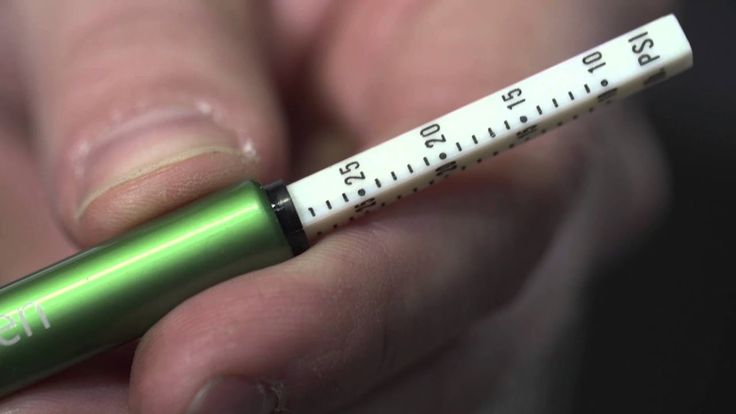 By pressing the gauge against the valve core, the gauge opens the valve to the internal air pressure of the tire and allows the gauge to act as the seal while simultaneously measuring the tire’s PSI rating.
By pressing the gauge against the valve core, the gauge opens the valve to the internal air pressure of the tire and allows the gauge to act as the seal while simultaneously measuring the tire’s PSI rating.
Advertisement
STEP 4: Check the reading on the tire pressure gauge.The tire pressure gauge should be held firmly against the open tire valve so that no air is escaping. If the tire pressure gauge is making a hissing sound, you need to adjust the angle of the gauge inside the tire valve until it is silent. This indicates that the tire pressure gauge is measuring the full tire pressure instead of getting a partial reading due to escaping air. To check the reading on the tire pressure gauge, simply read the slide ruler for manual pen gauges, the dial for dial pressure gauges, or the digital screen for digital pressure gauges. The ruler, dial, or screen should display the current tire pressure in PSI.
Photo: istockphoto.com
After taking the tire pressure measurement, write down the current pressure for each tire so that you don’t forget and need to check again. If the pressure within each tire is too high, you can easily drain some air by holding the tire pressure gauge against the tire valve at an angle, listening for the hiss of escaping air. Periodically check the tire pressure to ensure that you don’t drain too much air and stop once you reach the desired PSI.
If the pressure within each tire is too high, you can easily drain some air by holding the tire pressure gauge against the tire valve at an angle, listening for the hiss of escaping air. Periodically check the tire pressure to ensure that you don’t drain too much air and stop once you reach the desired PSI.
If the pressure within the tire is too low, connect an air compressor such as this portable inflator—a favorite in our researched guide to the best tire inflators—to the tire valve to inflate it. After inflating the tire, use the tire pressure gauge to check the PSI and make sure it is now at the correct level according to the manufacturer’s recommendations.
It’s advised to check the tire pressure on your vehicle at least once per month to ensure that you are safe while driving and not doing any unexpected damage to your tires.
Advertisement
RELATED: I Tried a Cordless Tire Inflator―Did It Work?
Final ThoughtsEffectively using a tire pressure gauge is a necessary skill for a driver to have in order to be certain that their vehicle is properly maintained.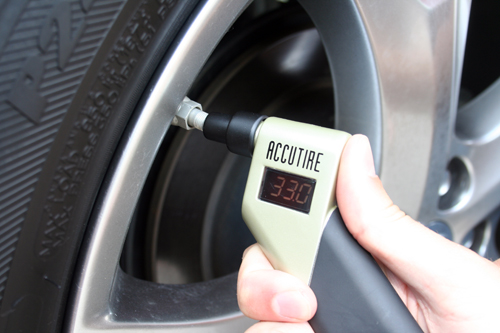 Additionally, by checking the tire pressure of the vehicle, drivers can ensure that they are getting the most out of each tire, instead of accidentally causing premature wear and tear due to overinflated or underinflated tires. Also, keep in mind that you can deflate a car tire with only a tire pressure gauge, but to fill the tire you will need access to an air compressor and a suitable attachment for filling tires. Consider investing in a home air compressor or find a local gas station that has one available for use.
Additionally, by checking the tire pressure of the vehicle, drivers can ensure that they are getting the most out of each tire, instead of accidentally causing premature wear and tear due to overinflated or underinflated tires. Also, keep in mind that you can deflate a car tire with only a tire pressure gauge, but to fill the tire you will need access to an air compressor and a suitable attachment for filling tires. Consider investing in a home air compressor or find a local gas station that has one available for use.
Advertisement
Maintaining proper tire inflation is relatively simple and essential to the overall tire performance of your vehicle. A properly inflated tire will provide longer life, quicker steering response, better fuel efficiency and a smoother ride than an improperly inflated tire. Both underinflation and overinflation can cause headaches like premature treadwear and possible tire failure. The best way to ensure you're getting the most out of your tires is to check your tire pressure on a monthly basis.
Knowing how to use a tire pressure gauge is very simple. Here’s how to check tire pressure and refill your tires.
Items You Need When Checking Tire Pressure
Tire pressure gauge
Air compressor
Pen and paper
Your tire pressure gauge can be digital or standard. Auto parts stores typically carry both. Many auto parts stores sell portable air compressors that run from your car battery or 12v power port. Alternatively, you can use the air compressor found at most gas stations. They usually cost $0.50 or $1.00 to use.
Vehicle manufacturers specify PSI – literally “pounds per square inch” of pressure – assuming tires are cold. Tires are considered cold when the vehicle has been parked for three hours or more, or if the vehicle has been driven less than a mile (1.6 km) at moderate speed. PSI is the unit your pressure gauge uses to provide readings.
Look on the driver’s side door jamb or your owner’s manual to find the recommended cold tire PSI for your front and rear tires. If you cannot find it, you should consult your vehicle dealer, manufacturer, or a qualified tire professional.
If you cannot find it, you should consult your vehicle dealer, manufacturer, or a qualified tire professional.
If your front and rear tires require different pressure levels, write down the correct PSI for each to avoid getting confused as you move around your vehicle checking tire pressure.
Remove the valve cap from one of your tires. Then place the pressure gauge on the valve stem and press down hard enough so the hiss sound disappears and your gauge provides a reading. With a standard gauge, the air pressure will push a small bar out from the bottom of the gauge. Measurement units are etched into the bar. A digital gauge will show you the reading on a screen.
Write down the reading and repeat this process for all four tires.
Use an air compressor to refill any tires with low pressure. Many air compressors are different, so read directions carefully to be sure you’re using it correctly.
If you’re using the air compressor at a gas station, be sure to park so that the hose will reach all four tires. Insert change into the machine until you hear the motor running. Fill each tire by placing the end of the hose over the valve stem and pressing on the lever.
Using a gas station air compressor means your tires might be “hot.” If it is necessary to adjust inflation pressure when tires are “hot”, set their pressure to 4 psi (14 kPa) above the recommended cold inflation pressure. Recheck the inflation pressure when the tires are cold.
After filling your tires, use the gauge to check pressure again. At this point, it’s ok if you overfilled the tires because you can always let some air back out. Never drive on overinflated tires. Overinflation can result in decreased traction, premature wear, and decreased impact absorption.
Make the above procedure a monthly ritual. Regularly checking your tire pressure is the best way to ensure your tires never dip far below the optimal PSI.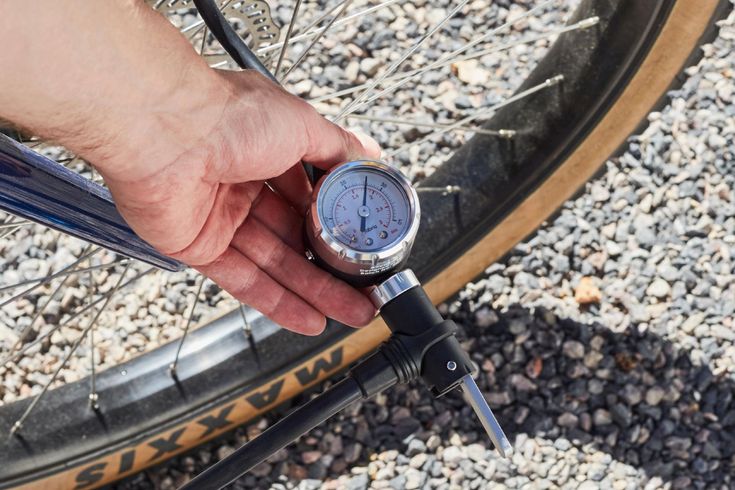
Accuracy matters and you should keep that in mind when choosing a gauge. For just a few dollars, you can find a quality, accurate tire pressure gauge that gives accurate readings. If you’re not sure which one to purchase, ask a professional technician which he or she prefers.
A digital tire pressure gauge will provide accurate readings, but don’t forget that it operates on a battery. If you think having to replace the battery will prevent you from using it, it’s best to go with a standard gauge.
It’s best to use your personal tire gauge versus those available attached to air hoses at service stations. Of all the pressure gauges out there, they’re the most likely to be weathered, and possibly inaccurate.
There’s never a good time for a flat. That’s why Bridgestone DriveGuard tires are masterfully engineered to keep you moving for up to 50 miles at speeds up to 50 MPH without disruption.
There’s never a good time for a flat. That’s why Bridgestone DriveGuard tires are masterfully engineered to keep you moving for up to 50 miles at speeds up to 50 MPH without disruption.
That’s why Bridgestone DriveGuard tires are masterfully engineered to keep you moving for up to 50 miles at speeds up to 50 MPH without disruption.
See Details Find Your Fit
All pressure gauges built into the compressors show incorrect values! And the reason is not only the inaccuracy of the instruments.
The examination of compressors with digital pressure gauges did not involve big "discoveries". However, at the very first measurements, an interesting thing turned out: the reference pressure gauge showed that the pressure in the inflated tire was not at all the same as that set for the compressor. They took another compressor - the tire again turned out to be under-inflated. And so it was repeated with all the devices. Why?
Related materials
10 pumps: Compressor expertiseTire pressure monitoring systems - how they workTire pressure: your norm
First thought: regular pressure gauges lie.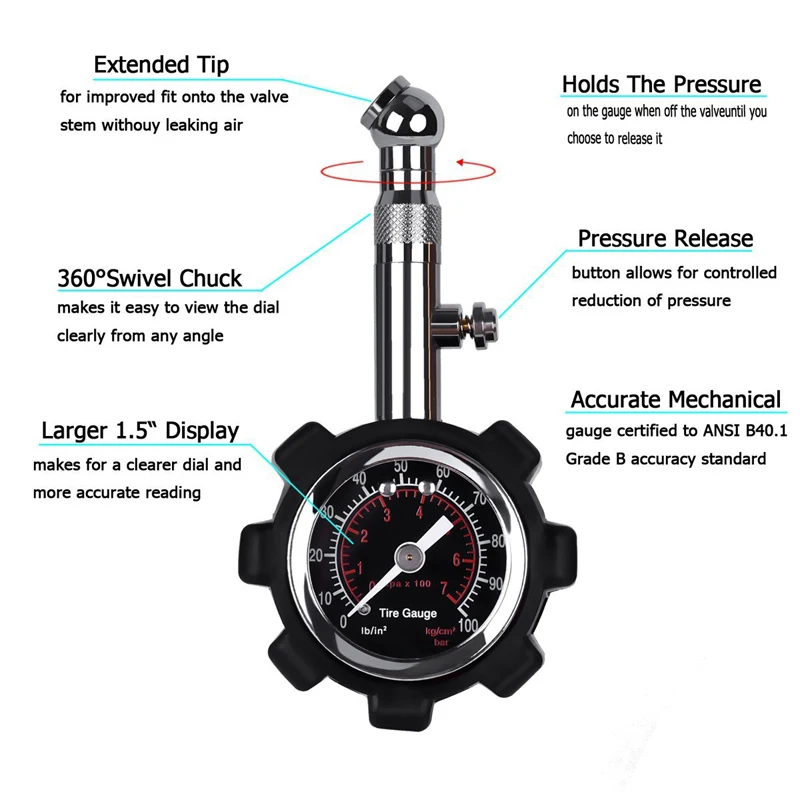 To check them, a splitter was connected to the compressor hose. One of its sleeves was connected to an exemplary pressure gauge, and the other to the inflated wheel.
To check them, a splitter was connected to the compressor hose. One of its sleeves was connected to an exemplary pressure gauge, and the other to the inflated wheel.
Related materials
How to inflate a tire without a pump? 5 myths and 2 risky ways
Indeed, they all lied, but at the same time, the pressure in the inflated tire still did not correspond to the required one. An exemplary pressure gauge connected to a running compressor showed 2.0 bar, but as soon as the electric motor died, the pressure decreased to 1.8 bar. The same exemplary pressure gauge showed when connected directly to the wheel valve. How to explain this fact?
The fact is that approximately 0.2 bar is lost when overcoming a narrow bottle neck - channels in the spool. As soon as the compressor turns off and the air flow becomes equal to zero, the pressure in the entire system immediately equalizes - then the error of the compressor pressure gauge can be estimated.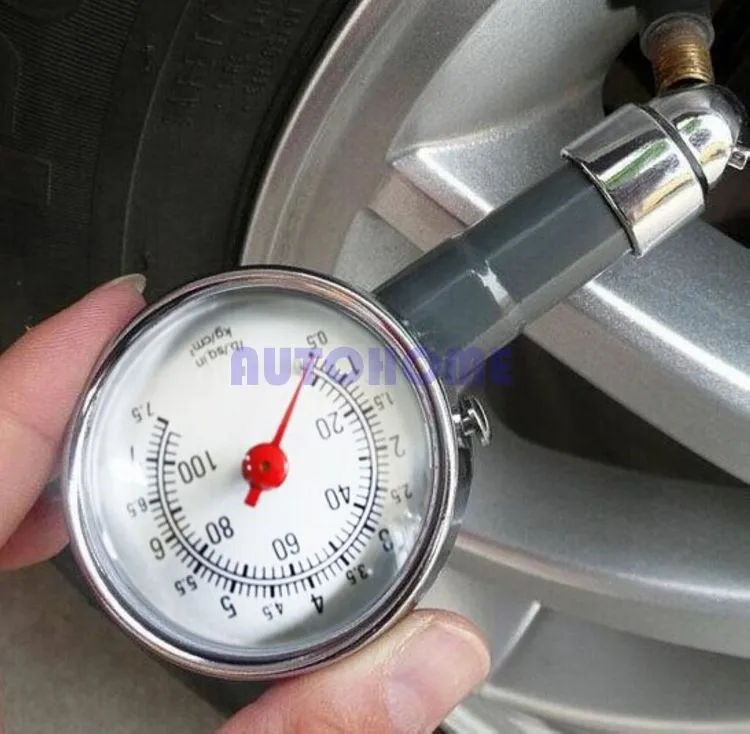
Related materials
Pump up or inflate? Non-Standard Compressor Test
Understanding came when they guessed to connect a valve turned out of the wheel to a running compressor. It would seem that the pressure gauge should show zero: after all, there is no back pressure. However, the very first experience showed an excess of 0.4 bar! Having gone through several valves from different manufacturers, we determined the range of "overestimations" - from 0.4 to 0.6 bar.
The variation in readings depends on how much the valve stem moves when the compressor hose nozzle presses on it . Just don’t think that we didn’t fit or screw the pump tip onto the valve tightly enough. If the tip does not press the spool pin at all, the valve will open at a pressure of at least 5 bar. And such an ordinary automobile compressor develops with great difficulty.
Scheme of installation for checking pressure gauges of compressors
1 - wheel, 2 - valve, 3 - reference pressure gauge, 4 - test compressor with built-in pressure gauge.
This "error" is easiest to catch when you inflate a completely flat tire. The pressure gauge in the first second of compressor operation will show a pressure of at least 0.4 bar. This is the backwater formed by very narrow sections for the passage of air in the spool. And its value is maximum on a flat tire. Why does it decrease as the tire pressure increases?
Related materials
Small-sized tire compressors: expertise of the magazine "Behind the wheel"
At the beginning of pumping, the flow is maximum, the speed is high and the resistance (it is proportional to the square of the speed) is greater. As the tire is inflated, it becomes harder for the compressor to pump, the air consumption drops, and with it, the resistance on the spool decreases. Therefore, at high pressures, compressor pressure gauges show tire pressure more and more accurately. And at the maximum pressure that the pump can develop, the flow rate, and with it the back pressure, tend to zero. And the measurement error disappears.
And the measurement error disappears.
The connecting element, slipped or screwed onto the valve, also plays a role in the resistance of the air supply line from the compressor to the tire. The largest air passage is provided by tap type tips, and the greatest resistance - up to 0.15 bar - is provided by tips with a narrow gap. But it is especially important that the tip fully presses the spool valve. Because if it does not fully open, the resistance of the spool will become even greater. The correct connection of the tip to the valve is important here. It is necessary to ensure the tightest possible putting on (or screwing) of the tip.
Compressor tips are available in different designs. The larger the cross section, the better for the passage of air.
Compressor tips are available in different designs. The larger the cross section, the better for the passage of air.
It remains to recognize the obvious: it is impossible to accurately set the pressure using compressor pressure gauges .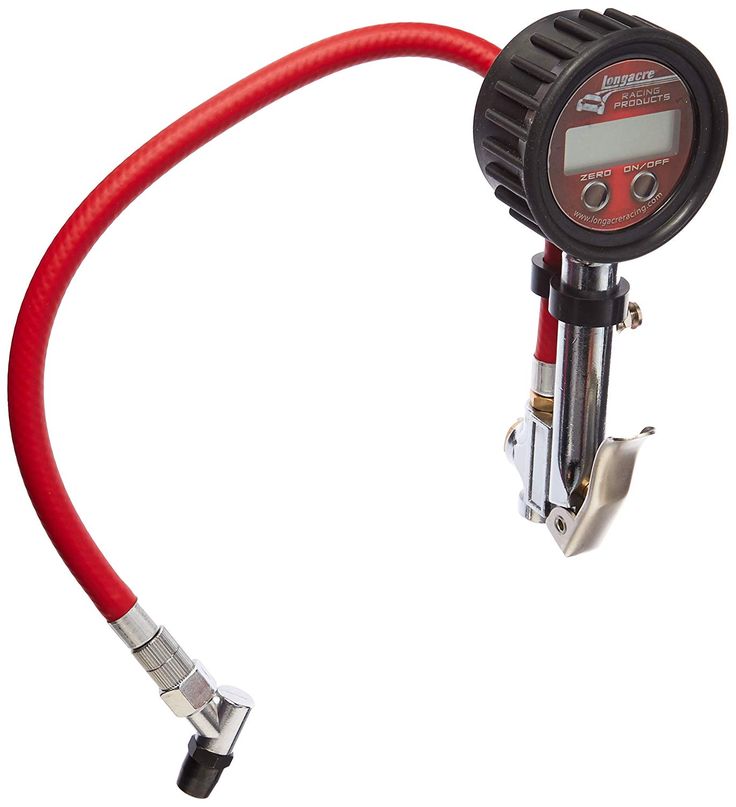 After all, any valve is an obstacle to the air flow. And any obstacle creates the same counterpressure. For this reason, in all compressors, the generated pressure always exceeds that which we later measure directly on the wheel. Therefore, even the most accurate built-in device will always show a pressure higher than in the tire. And accordingly, the compressor will turn off earlier than necessary.
After all, any valve is an obstacle to the air flow. And any obstacle creates the same counterpressure. For this reason, in all compressors, the generated pressure always exceeds that which we later measure directly on the wheel. Therefore, even the most accurate built-in device will always show a pressure higher than in the tire. And accordingly, the compressor will turn off earlier than necessary.
It is better to inflate the wheel with a margin, measure the pressure with an accurate pressure gauge and bring it back to normal by bleeding excess air from the tire.
Related materials
Choosing a tire pressure gauge - cheaper and more accurate
You can set the pressure with some advance. If you need to get 2.0 bar, you should inflate the wheel to 2.2 bar. However, different valves create different back pressure, the value of which is not known in advance. And even in one car, she can walk from wheel to wheel.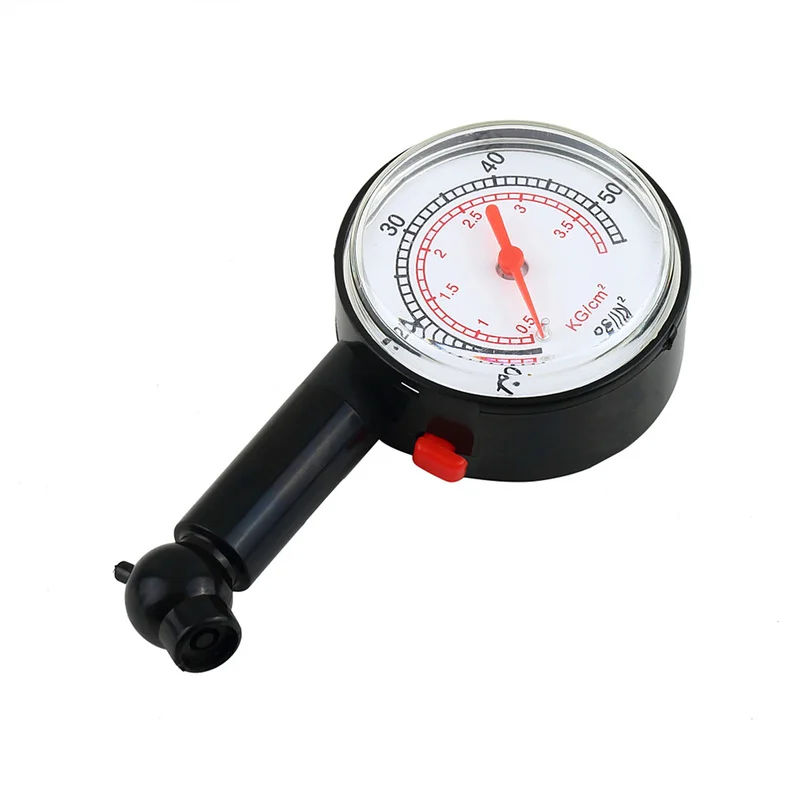 We encountered this phenomenon in the examination of electronic pressure gauges (we will publish it in the September issue of the journal). By the way, in most cases their accuracy is higher than that of devices built into compressors. Therefore, we advise everyone to get such a pressure gauge in addition to the compressor.
We encountered this phenomenon in the examination of electronic pressure gauges (we will publish it in the September issue of the journal). By the way, in most cases their accuracy is higher than that of devices built into compressors. Therefore, we advise everyone to get such a pressure gauge in addition to the compressor.
As a result of , the surest way is to inflate the wheel to a known higher pressure, with an excess of 0.2–0.3 bar, and then measure the actual pressure with a pressure gauge, bleeding air from the tire if necessary .
OUR REFERENCE
Spool design
2 - seal; 3 - threaded bushing; 4 - spool rod; 5 - valve body; 6 — valve body; 7 - conical spring; 8 - valve cup. The spools of the old (a) and new (b) samples are completely interchangeable. The air resistance is about the same.
If you looked into the wheel valve hole, you probably saw a spool there. This device, standardized throughout the world, is used not only in the wheels of cars, motorcycles and bicycles, but also in air conditioners, scuba gear and other elements of pneumatic equipment.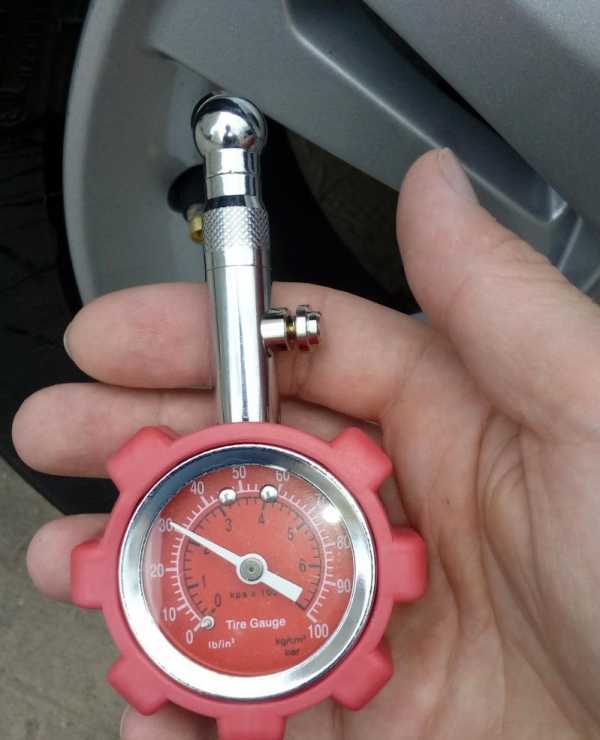
It is the Schrader valve that creates the main resistance to the air flow. Due to its influence, no pressure gauge will show the correct pressure while the compressor is inflating the wheel.
Discount
New
Internal product code: 9242
Code: 14211
Wholesale price
1 107 ₽ retail price
In stock
Tire pressure gauge "Shinomer" 12atm
This product is also in the following categories: Automotive pressure gauges, Pump guns, Tire pressure gauges
Address
Schedule
Availability
Phone
Moscow region Leninsky district, Aparinki village, warehouse complex Aparinki (own. 11)
11)
Mon-Fri from 7:00 to 17:00
Available
8 (800) 333-31-59
Shipping
Also order
Customers ask
Documents are now glued to the wall of one of the boxes from the outside in an A4 envelope.
The main advantages of working with Autolong.ru:
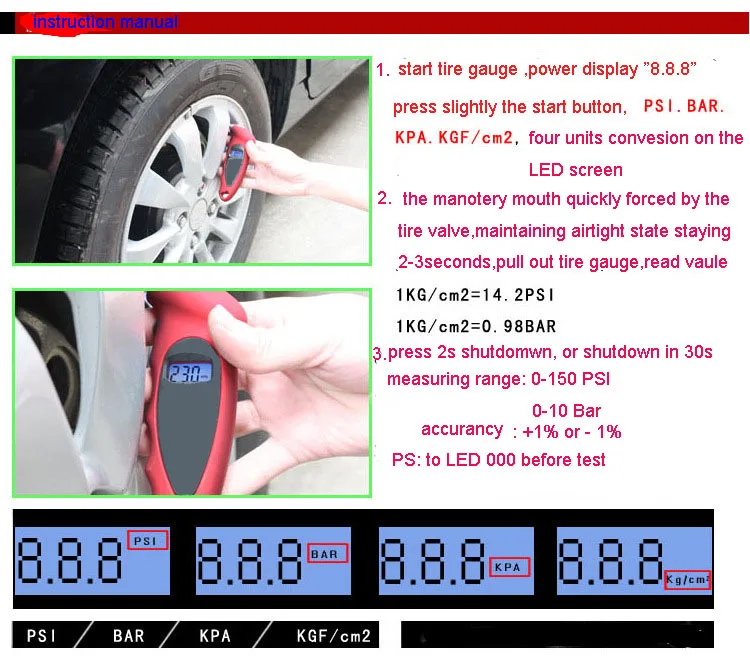
When transporting goods by road, the driver must have the appropriate set of documents. First of all, it is a bill of lading. This document defines the relationship between the sender and the recipient of the cargo. Thus, the invoice serves, in particular, to write off products from the consignor's warehouse and post them to the consignee's warehouse. Also, the consignment note defines the relationship between the consignor and the cargo delivery service that carries out transportation on this transport. This part of the document is used to account for the provided transport services and payments for the services provided. The bill of lading must be issued in several copies. One copy always remains with the consignor, others, certified by signatures and seals, are handed over to the driver. The driver hands over one of the copies to the consignee, and the rest serve as the basis for paying for the transportation. When transporting goods by road, it is necessary to have a waybill drawn up in accordance with the requirements of Russian legislation. The driver carrying out the transportation must have a copy of his employment contract.
This part of the document is used to account for the provided transport services and payments for the services provided. The bill of lading must be issued in several copies. One copy always remains with the consignor, others, certified by signatures and seals, are handed over to the driver. The driver hands over one of the copies to the consignee, and the rest serve as the basis for paying for the transportation. When transporting goods by road, it is necessary to have a waybill drawn up in accordance with the requirements of Russian legislation. The driver carrying out the transportation must have a copy of his employment contract.
There are two ways to place and send an order from autolong.ru. The first way to order is directly through the "Basket" on the site. In order to place an order, you must go to the "Catalog" section, select the subsection you are interested in and the necessary goods. You can also filter products by price or when they were added to the catalog by using the filter next to the category name.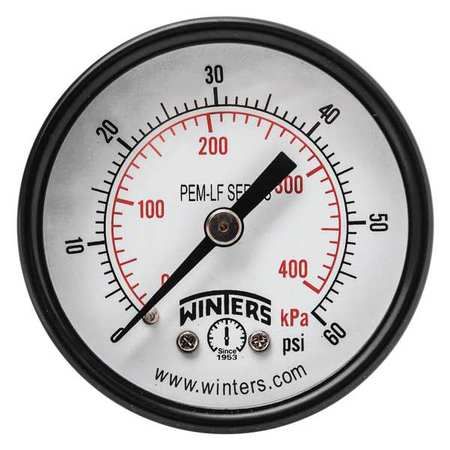 Select the number of items you need. At the top of the page, you will be able to see the total quantity of the item you ordered and the final amount. To place an order and send it to us, click on the shopping cart icon in the upper right corner of the site. Check your order in the list that opens. At this stage, you can remove any items from the order or recalculate their quantity. Click the "Checkout" button. In the page that opens, fill in your details and click the "Place an order" button again. Your order will then be sent to us for processing. Attention! Indicate your existing data, because. our manager will contact you to confirm the order. After confirming the order at the company's warehouse, you will be issued a non-cash invoice or sent a link to pay by card.
Select the number of items you need. At the top of the page, you will be able to see the total quantity of the item you ordered and the final amount. To place an order and send it to us, click on the shopping cart icon in the upper right corner of the site. Check your order in the list that opens. At this stage, you can remove any items from the order or recalculate their quantity. Click the "Checkout" button. In the page that opens, fill in your details and click the "Place an order" button again. Your order will then be sent to us for processing. Attention! Indicate your existing data, because. our manager will contact you to confirm the order. After confirming the order at the company's warehouse, you will be issued a non-cash invoice or sent a link to pay by card.
The second method is more suitable for wholesale customers with whom we have been working for a long time and who know our entire range well, as well as for those who have a slow or unstable Internet connection.